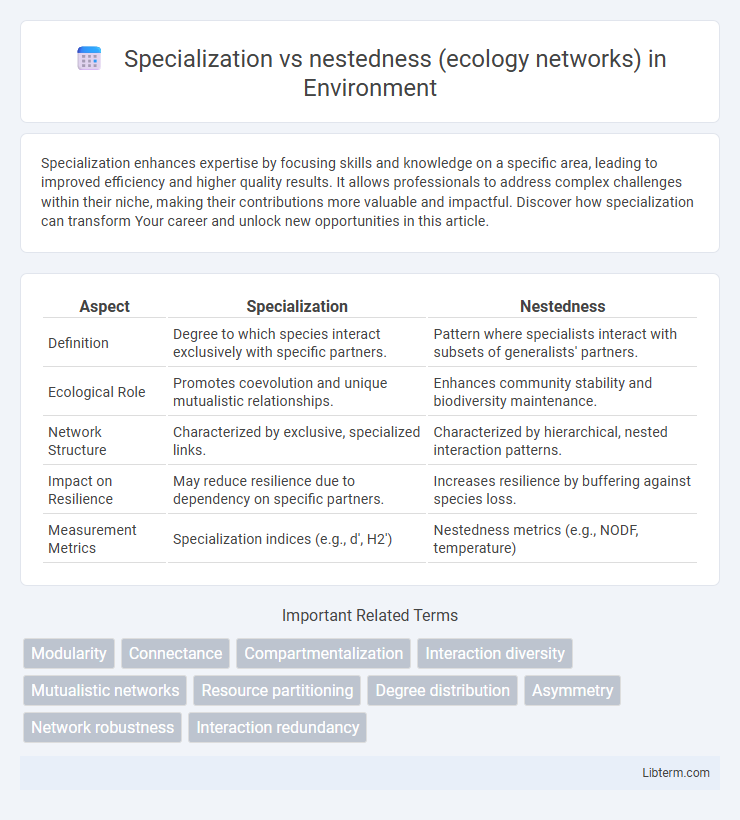Specialization enhances expertise by focusing skills and knowledge on a specific area, leading to improved efficiency and higher quality results. It allows professionals to address complex challenges within their niche, making their contributions more valuable and impactful. Discover how specialization can transform Your career and unlock new opportunities in this article.
Table of Comparison
| Aspect | Specialization | Nestedness |
|---|---|---|
| Definition | Degree to which species interact exclusively with specific partners. | Pattern where specialists interact with subsets of generalists' partners. |
| Ecological Role | Promotes coevolution and unique mutualistic relationships. | Enhances community stability and biodiversity maintenance. |
| Network Structure | Characterized by exclusive, specialized links. | Characterized by hierarchical, nested interaction patterns. |
| Impact on Resilience | May reduce resilience due to dependency on specific partners. | Increases resilience by buffering against species loss. |
| Measurement Metrics | Specialization indices (e.g., d', H2') | Nestedness metrics (e.g., NODF, temperature) |
Introduction to Ecological Networks
Ecological networks reveal complex interactions among species, where specialization denotes species engaging with limited partners, enhancing niche differentiation and ecosystem stability. Nestedness describes a structured pattern where specialist species' interactions form subsets of generalists' interactions, contributing to network robustness and biodiversity maintenance. Understanding the balance between specialization and nestedness in ecological networks is essential for predicting community resilience and functional dynamics in ecosystems.
Defining Specialization in Ecological Contexts
Specialization in ecological networks refers to the degree to which species interact exclusively with a limited number of partners, enhancing niche differentiation and reducing competition. It is quantified through metrics such as H2' and d', which measure overall network specialization and individual species specialization, respectively. High specialization can lead to increased vulnerability but also stabilizes mutualistic interactions by reinforcing species-specific dependencies.
Understanding Nestedness in Ecological Networks
Understanding nestedness in ecological networks reveals patterns where specialist species interact with subsets of generalist species' partners, creating hierarchical structures that enhance community stability. Nestedness metrics, such as the Nestedness Temperature Calculator and NODF (Nestedness metric based on Overlap and Decreasing Fill), quantify the degree to which interaction matrices exhibit ordered subsets. Analyzing nestedness in mutualistic networks like plant-pollinator or host-parasite systems informs about resilience to species loss and ecosystem functioning.
Key Metrics for Assessing Specialization
Key metrics for assessing specialization in ecological networks include H2', d', and specificity indices, which quantify the degree of exclusiveness between species interactions. H2' measures overall network-level specialization by comparing observed interactions against a null model, capturing deviation from random associations. The d' index evaluates species-level specialization, reflecting how selectively a species interacts within a nested or modular network structure.
Quantitative Approaches to Measuring Nestedness
Quantitative approaches to measuring nestedness in ecological networks utilize metrics like NODF (Nestedness metric based on Overlap and Decreasing Fill) and WNODF, which account for weighted interactions between species to reflect interaction strength. These methods improve detection of nested patterns by incorporating abundance and frequency data, offering finer resolution compared to binary metrics in assessing specialization and nestedness relationships. Advanced algorithms also apply null models to distinguish nestedness from random interaction structures, enhancing ecological network interpretation.
Ecological Implications of Specialization
Specialization in ecological networks often leads to increased resilience by promoting tight species interactions and resource partitioning, reducing competition and enhancing ecosystem stability. High specialization can drive coevolutionary processes, fostering unique adaptations and dependency patterns that influence community structure and biodiversity. However, specialized species may be more vulnerable to environmental changes and extinctions, potentially disrupting network functionality and ecosystem services.
Functional Consequences of Nestedness
Nestedness in ecological networks enhances community stability by promoting species coexistence through asymmetric interaction patterns, where specialists interact with subsets of generalists' partners. This structural trait facilitates robustness against extinctions, as loss of specialist species has less impact on network integrity due to overlapping interactions. Functional consequences include improved ecosystem resilience and maintenance of biodiversity, supporting processes such as pollination and seed dispersal efficiency.
Drivers Influencing Specialization vs Nestedness
Drivers influencing specialization in ecological networks include resource availability, species traits, and environmental stability, promoting exclusive interactions among species. Nestedness is primarily driven by interaction asymmetry, species abundance, and generalist behaviors that create a hierarchical pattern of interactions. Understanding these drivers helps reveal how ecological network structure supports biodiversity and ecosystem resilience.
Case Studies: Network Patterns in Real Ecosystems
Case studies of ecological networks reveal distinct patterns of specialization versus nestedness, where specialized interactions create modular structures while nestedness promotes species coexistence through hierarchical interaction patterns. For example, pollination networks often exhibit nested structures that enhance community stability, whereas host-parasite networks tend to show higher specialization reflecting coevolutionary pressures. Empirical data from tropical forest and marine ecosystems demonstrate how these network architectures influence resilience, biodiversity, and ecosystem functioning in real-world scenarios.
Future Directions for Research on Network Structure
Future research on network structure in ecology should prioritize integrating multi-layer ecological networks to capture both specialization and nestedness dynamics across different interaction types. Advanced modeling techniques, including machine learning and network motif analysis, offer promising avenues to unravel how specialization influences nestedness within complex ecological communities. Emphasizing temporal and spatial variability in network data will enhance understanding of how environmental changes affect the balance between specialization and nestedness in ecosystem resilience.
Specialization Infographic

 libterm.com
libterm.com